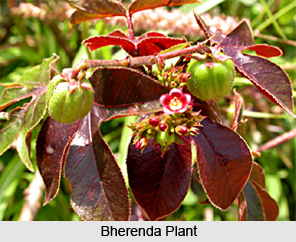 Bherenda is a common bushy, clustered shrub that can reach the height of up to 1.8 m. The botanical name of the plant is Jatropha gossypi folia L. and it is known by different names in various Indian languages. Bherenda is the Hindi name of the plant and it is also called as Verenda in Hindi. The Sanskrit name of the plant is dra-vanti. In Bengali, it is called as Lalbherenda and the Gujarati people know it as Nepalo or Vilayati Nepalo. The Malayalam name of the plant is Simaya-vanakku and in Oriya, it is known as Rangakalo. The Tamil speaking people call the plant as Adalai, Atalai, Kattamanakku or Simaiyamanakku and its Telugu names include Nela-Amida, Nepalemu and Simanepalemu.
Bherenda is a common bushy, clustered shrub that can reach the height of up to 1.8 m. The botanical name of the plant is Jatropha gossypi folia L. and it is known by different names in various Indian languages. Bherenda is the Hindi name of the plant and it is also called as Verenda in Hindi. The Sanskrit name of the plant is dra-vanti. In Bengali, it is called as Lalbherenda and the Gujarati people know it as Nepalo or Vilayati Nepalo. The Malayalam name of the plant is Simaya-vanakku and in Oriya, it is known as Rangakalo. The Tamil speaking people call the plant as Adalai, Atalai, Kattamanakku or Simaiyamanakku and its Telugu names include Nela-Amida, Nepalemu and Simanepalemu.
Bherenda is quite extensively found in various parts of India. The plant has been naturalised as a common weed in open degraded habitats like roadsides throughout most of the plain districts of India. However, Bherenda is not a native to India. It is a native to the American tropics from Central America and the West Indies southwards to Brazil. The plant was introduced as an ornamental plant in gardens in India. The plant flowers and fruits between the months of July and September in central India and usually remains leafless between February and April-May. However, the flowering and fruiting of Bherenda occur from February to July in southern India.
The leaves of Bherenda have a length of up to 20 cm and the wide leaves are palmately 3-5-lobed. The lobes are obovate, the margins are entire and the apex is shortly acuminate. The leaves with cordate base are of purplish-brown colour and shining when young and they later turn into green. The leaf margins, petioles and stipules remain covered with sticky, yellow glandular hairs. The small flowers of Bherenda are of dark red, crimson or purplish colour and are borne in glandular, terminal corymbose cymes. Bherenda`s fruit is oblong, rough and is about 1 cm across. The 3-lobed fruit is truncate at both ends and the seeds of the plant are greyish-red.
Bherenda has many medicinal properties and uses. The plant is frequently used in the traditional medicine, Ayurveda. A decoction of the bark of Bherenda is used as an emmenagogue and another decoction of the leaves is used as a purgative and stomachic to relieve stomach-ache. The people in southern Orissa orally take an aqueous extract of the stem bark of Bherenda to treat diarrhoea. The latex from the cut stem and branches is also applied to promote healing of ulcers. Sometimes, the leaves or a paste made from the leaf of Bherenda is applied for getting relief from boils, carbuncles, eczema, scabies and itches. People apply the leaf juice to sores on infants` tongues and use a cataplasm of the fresh leaves to relieve swollen breasts. The root, leaves and fruit of Bherenda are used quite commonly in Ayurvedic practice. Oil extracted from the seed is used as an external application by the rural inhabitants of Bhavnagar District in Gujarat to treat ringworm, eczema, scabies and rheumatism as well. However, one should be careful before using the seeds of Bherenda, as they can act as a drastic purgative and emetic and may also cause insanity.



















